Trefeglwys is a village and community in Montgomeryshire, situated on the B4569 road that arcs between Caersws and Llanidloes, mid-way between the two towns, just over six miles west of Newtown. The men of the community who fell during both World Wars are commemorated on a relatively modern war memorial plaque, which is affixed to Trefeglwys Memorial Hall.
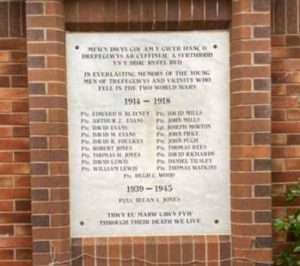
The Great War, 1914-1918
Edward Owen Blayney, Private, 203531, Royal Welsh Fusiliers. Edward was the son of Arthur and Elizabeth Blayney (nee Newell), of Cwmbelan, Trefeglwys. He worked as a Cowman prior to enlisting into the 4th Battalion, Royal Welsh Fusiliers at Welshpool on 14 February 1916, and was initially posted to the Army Reserve. He was mobilised on 18 January 1917 and was posted to Park Hall, Oswestry for training. Edward embarked for France at Southampton on 3 August 1917, joining the 5th Infantry Base Depot at Rouen. On 29 August 1917 he was posted to the 10th Battalion, Royal Welsh Fusiliers, which was in reserve at Fremicourt, attached to 76 Brigade, 3rd Division. On 2 September the 10th RWF moved into the front line at Louverval, to begin a short tour in the trenches, Edward’s first taste of trench warfare. On 17 September the Division entrained at Bapaume for Flanders, and detrained at Godewaersvelde, before marching into the Ypres Salient, reaching Ypres by 25 September and crossing the Hannebeek, to take part in the great Passchendaele offensive. On the following morning, 26 September, the Division launched its first assault at Ypres, crossing the Steenbeek and attacked Zonnebeke, reaching the Church before digging in. The 10th RWF remained here for several days, in terrible conditions, wet, windy and hostile. By 7 October 1917 Edward had been invalided to hospital in France, suffering from pleurisy, and within a week was taken to the 10th General Hospital at Rouen before being sent back to England for treatment, and was sent to the 1st Scottish General Hospital at Aberdeen to recuperate. He was then granted two weeks leave, and returned home after recovering. On 28 January 1918 he embarked for France again, joining the 2nd Battalion, Royal Welsh Fusiliers, but in April was admitted to hospital once more, suffering from scabies and pleurisy. He returned to duty on 11 May, re-joining the battalion, which by then was in the Somme sector, at Bouzincourt, attached to 115 Brigade, 38th (Welsh) Division. On 21 August 1918, 114 Brigade launched an assault across the flooded Ancre Valley, capturing Thiepval Ridge. On the following day, the 2nd RWF crossed the Ancre, and established a bridgehead after capturing Crucifix Corner, allowing the rest of the Division to cross on the following day. Over the coming days the Division drove forwards, capturing Pozieres and Contalmaison, before clearing Mametz Wood and Bazentin, and pushed forwards to Longueval and Delville Wood. By 30 August the Division had reached Lesboeufs, and at dawn on 1 September 1918 the Division launched a frontal assault against Morval and Sailly-Saillisel. Edward was killed in action during the fighting that day. The 21-year-old was buried in Sailly-Saillisel British Cemetery, France.
Arthur Zachariah Evans, Private, 94199, The King’s (Liverpool Regiment). Arthur was the son of Thomas and Elizabeth Evans, of Neuadd, Llawryglyn. He enlisted into the army at Welshpool, and was posted to a Training Reserve Battalion. After completing his training, Arthur was drafted to France early in 1918, where he was posted to the 17th Battalion, The King’s (Liverpool Regiment). The battalion was attached to 89 Brigade, 30th Division, and was in the St. Firming-Travecy Sector. On 10 February 1918 the battalion marched to Avricourt, to rest and refit, and remained there until 20 February when it marched to Flavy Des Meldeux, and onto billets in Aubigny. By 22 February the battalion was back in the Battle Zone in the St. Quentin Right Sub-Sector, and began supplying working parties, digging trenches and wiring. By now it had become obvious that the Germans were planning an attack, as much activity could be heard behind their lines, so the front-line Allied troops began to prepare for the onslaught. At dawn on 21 March 1918 this onslaught came, as the Germans opened up a murderous artillery barrage along a section of front line running south from Croisilles to La Fère, before launching a massed infantry assault. The 17th Liverpool’s took up counter-attack positions at Atilly, before meeting the Germans at Fluquieres, and heavy fighting ensued over the coming days as the Division was pushed back through Ham and Verlaines and Warvillers. The Division was relieved at the end of the month, moving to St. Valery-sur-Somme, before being transferred to the Ypres Salient, reaching Elverdinghe by 5 April, and took over the Poelcapelle Sector. The infantry battalions of the Division then began the regular routines of trench rotation, which usually comprised of four days in the front line, four in support and four in reserve. Arthur was wounded soon afterwards, probably during a hostile day on 19 April, and was evacuated to hospital at Boulogne, where he died of his wounds on 23 April 1918. The 19-year-old is buried in Boulogne Eastern Cemetery, France.
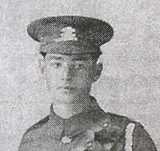
David Evans, Private, 291280, Royal Welsh Fusiliers. David was the son of David and Elizabeth Evans, of Penypound, Llawryglyn. He worked as a farm labourer prior to enlisting into the 3/7th Battalion, Royal Welsh Fusiliers at Newtown on 27 November 1915, and was posted to Park Hall, Oswestry for training. On 8 December 1916, David embarked for France at Southampton, joining the 5th Infantry Base Depot at Rouen. David did not leave the Depot, as he took ill soon after arriving in France, and was taken to the 25th General Hospital, where he died of broncho-pneumonia on 5 March 1917. David is buried in St. Sever Cemetery Extension, Rouen, France.
David William Evans, Private, 291417, Royal Welsh Fusiliers. David was the son of Griffith and Catherine Evans of Waenfawr, Pennant, Llanbrynmair. He worked as a waggoner and lived at Trefeglwys, Caersws prior to the war. David enlisted into the 3/7th Battalion, Royal Welsh Fusiliers at Newtown on 11 December 1915, and was initially placed on the Army Reserve before being mobilised on 13 February 1916, and was posted to Park Hall Camp, Oswestry for training. On 20 October 1916 David embarked for Egypt, and was posted to the 1/7th Battalion, Royal Welsh Fusiliers, which was attached to 158 Brigade, 53rd (Welsh) Division. The Division had been evacuated from Gallipoli in December 1915, moving to Egypt to join the EEF, and helped guard the Suez Canal before taking part in operations to drive the Turks out of the Sinai. The EEF then turned its attention onto driving the Turks out of Palestine, and on 26 March 1917 launched its first offensive against the coastal city of Gaza, which guarded the road to Jerusalem. Initial gains during the day were lost when the assaulting divisions lost touch with each other and communication broke down when a thick fog cloaked the battlefield. David was wounded during the battle, being shot in the arm, and did not return to duty until 4 August 1917. By now the EEF had been re-organised, with Sir Edmund Allenby assuming command, and a third offensive was launched against a wider front from Beersheba to Gaza on 31 October 1917. This time the Turkish defences were breached, and the road to Jerusalem now lay open and the EEF began to advance north. On 6 November 1917, 158 Brigade launched an attack on the Khuweilfeh Heights. David was posted as missing during the battle, but had been again wounded, and returned to duty on 2 January 1918. He was wounded for a third time in September 1918, as the Palestinian campaign was drawing to a close, and died of his wounds on 20 September 1918, aged 28. His service papers state that he died at Alexandria, so he should have a grave, but David is presently commemorated on the Jerusalem Memorial, Israel.
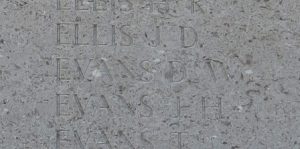
David Richard Foulkes, Private, 90278, Royal Welsh Fusiliers. David was the illegitimate son of Martha Foulkes, of Trefeglwys. He was raised by his grandparents at Trefeglwys, and then by his Aunt, Susan Foulkes, at Pantywain, Staylittle, Llanbrynmair. David enlisted at Wrexham into the 3rd Battalion, Royal Welsh Fusiliers, and was posted to Ireland, where the battalion was on garrison duties, following the Easter Risings. David took ill, and died of pneumonia in Limerick on 12 July 1918. The 22-year-old is buried in King’s Island Cemetery, Limerick, Ireland.
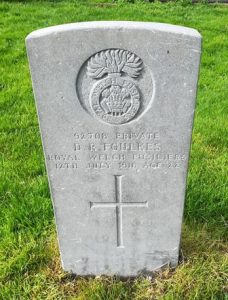
Thomas Francis, Private, 15329, Leinster Regiment (Royal Canadians). Thomas was born in Trefeglwys in 1882, the son of William and Elizabeth Francis. The family later resided at Comley, Church Stretton. Thomas worked as a waggoner at The Longnor Green Farm, Dorrington prior to the war. He enlisted at Shrewsbury into the King’s Shropshire Light Infantry, but was then transferred to the 2nd Battalion, Leinster Regiment (Royal Canadians). The battalion had landed in France on 12 September 1914, attached to 17 Brigade, 6th Division, and reinforced the BEF on the Aisne, before the entire BEF moved to Flanders. The Division took part in the Action of Hooge during June 1915, and were still in the area when the 2nd Leister’s transferred to the 24th Division at Reninghelst on 14 October 1915. The Division had suffered terrible casualties during the Battle of Loos the previous month, and did not return to action until the summer of 1916 when it was moved to the Somme. It then fought at Delville Wood and Guillemont, before moving north of Arras in early 1917. In April and May 1917, the Division fought at the Battle of Vimy, alongside the Canadian Corps, and in June it moved to positions south of Ypres, where it fought during the Battle of Messines. After the successful capture of Messines Ridge, the Division fought at the Battles of Pilckem and Langemarck during Third Ypres. The Division then moved to positions north of St. Quentin over the winter of 1917/18. During February 1918 the British army was re-organised, due to a lack of manpower, and the 2nd Leister’s transferred to 47 Brigade, 16th (Irish) Division at Tincourt. The Division was hit hard when it became caught up in the heavy fighting following the German Spring offensive of 21 March 1918, and after being forced to withdraw, was pulled out of the line, so the 2nd Leinster’s transferred again, joining 88 Brigade, 29th Division at Hondeghem. Thomas was wounded whilst the 2nd Leinster’s were holding the line near Le Boulevard in the middle of June, and was evacuated to hospital at Longuenesse, where he died of his wounds on 21 June 1918. The 36-year-old is buried in Longuenesse (St. Omer) Souvenir Cemetery, France. Thomas is not commemorated on the Trefeglwys war memorial.
Robert Jones, Private, 93936, Royal Welsh Fusiliers. Robert was the son of Edward and Sarah Jones, of Llwyntew, Trefeglwys. He worked as a miner in the Rhondda, prior to enlisting into the 3rd Battalion, South Wales Borderers at Pentre on 16 February 1916. Robert remained on home service for the next two years, and married Mary Elizabeth Morgan, of Caersws, in the Spring of 1918. In August 1918 he was drafted to France, initially to join the 10th Battalion, South Wales Borderers, but was instead posted to the 16th Battalion, Royal Welsh Fusiliers, joining the battalion on 30 September 1918. The battalion was attached to 113 Brigade, 38th (Welsh) Division, which, during the previous month, had launched an offensive across the River Ancre, before driving back the Germans across the old Somme battlefields of 1916. Robert joined the battalion near Sorel-le-Grand, where it was resting and refitting, following weeks of heavy fighting. On 3 October the battalion left its bivouacs, and marched to the railway cutting in front of Peiziere, and on the following day took over the line at Tombois Farm, Lempire, where it prepared to take part in an assault by the Division on Mortho Wood. The attacking battalions of the division moved into their positions on the night of 7 October, and at dawn the following day, 8 October 1918, launched an assault against the strongly defended wood, aided by a number of tanks, 113 Brigade leading, with 114 Brigade following up and leap-frogging the attackers. Robert was among almost 160 casualties suffered by the 16th RWF alone during the assault that day. The 25-year-old has no known grave and is commemorated on the Vis-en-Artois Memorial, Haucourt, France.
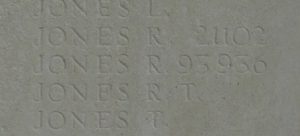
Thomas Hamer Jones, Private, 290939, Royal Welsh Fusiliers. Thomas was the son of Mary Jones, of Penypound, Llawryglyn. He worked as a lead miner prior to enlisting into the 7th Battalion, Royal Welsh Fusiliers at Llanidloes on 9 January 1915. The battalion was a Territorial unit, which mobilised for war at Newtown in August 1914, as part of North Wales Brigade, Welsh Division and moved to Conway until the end of the month, before moving to Northampton. In December the Division moved to Cambridge and then in May 1915 to Bedford, where the Division was numbered and the formation became 158 Brigade, 53rd (Welsh) Division. On 19 July 1915 the entire Division sailed from Devonport for Imbros and on 9 August 1915 landed at Suvla Bay. The infantry moved off the beaches into the bush, but due to a lack of maps and no knowledge of the terrain, many of the units became disorientated, and the situation became chaotic. The Division was eventually evacuated from Gallipoli in December 1915, moving to Egypt to join the EEF, and helped guard the Suez Canal before taking part in operations to drive the Turks out of the Sinai. The EEF then turned its attention onto driving the Turks out of Palestine, and on 26 March 1917 launched its first offensive against the coastal city of Gaza, which guarded the road to Jerusalem. Initial gains during the day were lost when the assaulting divisions lost touch with each other and communication broke down when a thick fog cloaked the battlefield. Thomas was killed in action during the terrible fighting that day. The 27-year-old has no known grave and is commemorated on the Jerusalem Memorial, Israel.
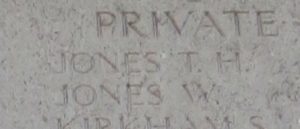
David Davies Lewis, Lance Corporal, G/25885, East Surrey Regiment. David was the son of Owen and Anne Lewis, of Ffynnongedwen, Trefeglwys. He married Elizabeth Minnie Trow in 1914, and the couple had two children over the coming years, Dorothy, born in 1914, and David, born in 1916. David enlisted into the Welsh Horse Yeomanry at Newtown. The regiment had formed in South Wales, and trained at Sophia Gardens, Cardiff, before being transferred to the Montgomeryshire T.F. Association with headquarters at Newtown. The 1/1st Battalion of the regiment joined the 1/1st North Midland Mounted Brigade of 1st Mounted Division in the Diss area, then in September 1915 the battalion dismounted and sailed from Liverpool aboard the RMS Olympic on 25 September 1915, landing at Anzac, Gallipoli on 10 October. David did not embark for Gallipoli with the battalion, but remained in Norfolk with the 2/1st Battalion. He was at some time posted to the 12th Battalion, East Surrey Regiment, which was attached to 122 Brigade, 41st Division. The Division had moved to France during May 1916, and began familiarisation with trench warfare in the Ploegsteert sector, remaining there until August 1916, when it moved to the Somme, and fought throughout the Somme offensive, before moving to positions south of Ypres in 1917. Here they took part in the Battle of Messines, before moving further north, where they fought at the Battle of Pilckem, and the Battle of the Menin Road, as part of the Third Battle of Ypres. The Division was selected as one of five British Divisions to be moved to Italy, as part of a reinforcement action taken by the Allies following a disastrous defeat of the Italian Army at Caporetto. By now the Italian front had stabilised, so the Division was hurried back to the Western Front in early March 1918. It then faced the German Spring Offensive of 21 March 1918, and fought in a gallant rear-guard action over the coming days, before being relieved and sent north to Flanders where it held a sector near Ypres that was, for once, relatively quiet. David was killed during a routine spell in the trenches here, at La Clytte, on 14 August 1918. The 29-year-old is buried in La Clytte Military Cemetery, Belgium. His brother, William, had been killed the previous year.
William Lewis, Private, 73765, Royal Welsh Fusiliers. William was the son of Owen and Anne Lewis, of Ffynnongedwen, Trefeglwys. He enlisted into the Royal Welsh Fusiliers at Welshpool, and probably trained at Kinmel Park prior to being drafted to France in the winter of 1917. William was posted to the 19th Battalion, Royal Welsh Fusiliers, which was attached to 119 Brigade, 40th (Bantam) Division. The Division had spent most of 1917 on the Arras front, having followed the German withdrawal to the Hindenburg Line in March 1917, and on 20 November 1917 had launched its famous assault on Bourlon Wood, during the opening phase of the Battle of Cambrai. On the night of 25-26 November, the battered Division was relieved, and moved back into huts at Lechelles, before moving out of the battle zone to Bienvillers by rail. On 2 December the Division moved back into the line, taking over the Bullecourt sector, and began work on consolidating and improving the trenches. William was wounded here, probably on 14 December, and was evacuated to a Field Hospital at St. Leger, where he died of his wounds on 15 December 1917. The 18-year-old is buried in St. Leger British Cemetery, France. His brother, David, was killed the following year.
William Meredith, Driver, 74008, Royal Field Artillery. William was the son of Edwin and Susannah Meredith, of Commins, Trefeglwys. He worked as a collier in the Rhondda, and resided at Salisbury Terrace, Brithdir prior to the war. William enlisted into the Royal Field Artillery at Bargoed on 6 January 1915, and was posted to Preston for training. He was then posted to C Battery, 110th Brigade, Royal Field Artillery, which was attached to the 25th Division, and landed in France on 26 September 1915. The Division saw its first major action during the Somme offensive in the summer of 1916, before moving north to Ploegsteert, where it held the line for the months leading up the Battle of Messines in June 1917. After fighting at the Battle of Messines, the Division fought during the Battle of the Pilckem Ridge, before moving south again, and took up positions around Bullecourt in reserve. The Division saw heavy fighting during the German Spring offensive of 21 March 1918, before being relieved and moving north again, but was hit again when the Germans launched the second phase of their offensive along the Lys Valley. The battered Division was then moved south, to the peaceful Aisne sector to rest and refit, but on 27 May got caught up in the third, and last, phase of the German offensive, and the Division was virtually annihilated. By 25 June 1918 William had returned to England, and was attached to the 4th Reserve Brigade, Royal Field Artillery. He was demobilised after the Armistice and returned home to Trefeglwys, but his health had been ruined due to his service in the war, and William died of pulmonary phthisis at Commins on 20 July 1920. The 29-year-old was buried in St. Michael’s Churchyard, Kerry. William is not currently commemorated by the CWGC as a casualty of war, but I have recently submitted his case, and it is awaiting adjudication. He is not named on the Trefeglwys war memorial.
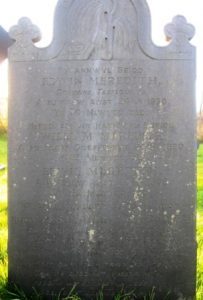
David Mills, Private, 12419, South African Infantry. David was the son of Hugh and Mary Mills, of Pantyglyn, Trefeglwys. He married Sarah Ann Bennett prior to 1907, but by 1909 had left his wife and two sons behind at 3, Chapel Street, Llanidloes, when he went to work in South Africa. Following the outbreak of war, David enlisted into the 4th Regiment, South African Infantry. The Regiment embarked for North Africa with the South African Brigade, and saw action against the Turks on the Suez Canal, before being sent to France in 1916, joining the 9th (Scottish) Division. The Division was by then on the Somme, and the South Africans saw their first major action here during the Battle of Bazentin, where the Division captured Longueval. They then fought at the Battle of Delville Wood, and the Battle of Le Transloy, and in April 1917 were at Arras, where they fought at the First Battle of the Scarpe and the Third Battle of the Scarpe. The Division moved north to Ypres, and fought at the Battle of the Menin Road, and at the First Battle of Passchendaele, before being moved to Cambrai, and fighting at the Action of Welsh Ridge. In March 1918 the Division was still in the Cambrai area, when it became one of the Divisions hit there by the German Spring Offensive of 21 March 1918. The 4th Regiment was in the Suzanne sector with the Division when the Germans hit, and saw terrible fighting over the coming days. David was killed in action on the fourth day of the fighting, on 24 March 1918. The 37-year-old has no known grave and is commemorated on the Pozieres Memorial, France.
John Mills, Private, 57783, Machine Gun Corps. John was the son of David and Hannah Mills, of Pantle, Trefeglwys. He enlisted at Wrexham into the army, and specialised as a machine-gunner before being drafted to France, joining the 46th Company, Machine Gun Corps, which was attached to the 15th (Scottish) Division. The Company was formed on 11 February 1916, and saw its first major with the Division during the Somme offensive in the summer of 1916, taking part in the Battle of Pozieres, and then fought at Battle of Flers-Courcelette, where the Division captured Martinpuich. In October the Division fought at the Battle of Le Transloy, and also in the Attacks on the Butte de Warlencourt. By May 1917 the Division was at Arras, and fought at the First Battle of the Scarpe, and then at the Second Battle of the Scarpe, where it captured Guemappe. The Division then moved north to Ypres at the end of May 1917, to prepare for the forthcoming Passchendaele offensive. On 28 July the 46th Company moved out of Toronto Camp and made its way to its battle positions, at Cambridge Trench and St. James’ Trench, and awaited zero hour. At 03.50 on 31 July 1917 the Battle of Passchendaele opened, and the 46th Company opened up a machine-gun barrage onto the German lines. The infantry then began their assault, so the machine-gunners lifted and opened fire on their second objectives, in front of the infantry, and 1hr 23 minutes later opened fire onto their third objectives. The guns then moved forwards, taking over new positions in the old German lines, and continued firing throughout the day. John was killed in action at some time during this opening day of the offensive. The 24-year-old has no known grave and is commemorated on the Ypres (Menin Gate) Memorial, Belgium.
Joseph Morton, Lance Sergeant, 21429, Royal Welsh Fusiliers. Joseph was born at Greenock, Renfrewshire on 23 January 1886, the son of Margaret Morton. He had left home as a young man and by 1901 was working at Clunie Farm, Kirkcudbrightshire. Joseph enlisted into the Royal Navy on 23 January 1904, and served for five years before being discharged on 14 June 1909, as he had refused to do any more work, and was sentenced to 41 days hard labour. He then moved to mid Wales, and became a cowman at Branchyfedw, Staylittle. Joseph enlisted into the Royal Welsh Fusiliers at Llanidloes soon after the outbreak of war, and was posted to the 14th Battalion, Royal Welsh Fusiliers. The battalion was raised at Llandudno by the Welsh National Executive Committee, joining 128 Brigade, 43rd (Welsh) Division and trained in North Wales before moving to Winchester in the summer of 1915, where the formation became renumbered 113 Brigade, 38th (Welsh) Division. The Division moved to France on 2 December 1915 and moved to the Nursery Sector near Fleurbaix for trench initiation alongside the Guards Division. The Division then held a sector of the line near Cuinchy before marching south to the Somme sector in June 1916 to take part in the assault on Mametz Wood. The first attack on the wood was launched on a two-battalion front on 7 July, but failed, and the Divisional Commander, Sir Ivor Philipps, was replaced before the Division attacked again on a two Brigade front on 10 July 1916. After two days of ferocious hand-to-hand fighting, the wood was cleared up to its northern edge, before the battered Division was relieved. It then took over a section of the front at Hébuterne before moving to the Ypres Salient, and taking over the Canal Bank sector at Boesinghe. The infantry battalions of the Division then began carrying out the normal pattern of rotation in the trenches, four days in the front, four in support and four in reserve, whilst also working on trench improvement, digging new trenches, and also carrying out regular patrols and trench raids. On 31 July 1917 the Division launched its famous assault on the Pilckem Ridge, capturing Iron Cross and reaching its objective of the Steenbeek. Joseph was killed in action at some time during the assault that day. The 31-year-old has no known grave and is commemorated on the Ypres (Menin Gate) Memorial, Belgium.
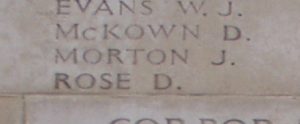
David Orrells, Lance Corporal, S/4252, Rifle Brigade. David was born in Trefeglwys in 1883, the son of David Orrells and Ann Orrells (nee Evans). By 1892 the family had moved to Ystradfodwg, in the Rhondda Valley. David enlisted at Treherbert into the Cardigan Battery, Royal Garrison Artillery on 5 March 1901. The Battery was a Volunteer unit, which became a TA unit in 1908, so David would have attended annual summer camps over the coming years. David’s father died in 1904, and the family moved to 32, Gelli Road, Gelli, Pentre Rhondda, where young David worked as a coal miner. He enlisted at Pentre into the Rifle Brigade soon after the outbreak of war, and was posted to France on 29 July 1915, joining the 3rd Battalion, Rifle Brigade. The battalion was holding a sector of the line NE of Ypres, attached to 17 Brigade, 6th Division when David arrived. The battalion remained at Ypres over the coming months, then on 14 October 1915 the battalion transferred to the 24th Division. The Division had only arrived in France in August 1915, yet its inexperienced troops had been thrown into action during the Battle of Loos on 26 September 1915, and suffered terrible casualties. It was then withdrawn from the line to rebuild and refit, before taking over a quiet sector near Kemmel. The Division moved from Kemmel at the end of July 1916, and transferred to the Somme, taking part in the fierce fighting for Delville Wood and Guillemont, before moving north to the Mazingarbe sector early in September 1916. In May 1917 the Division moved north to Brandhoek, before taking up positions at Wytschaete, where it fought during the Battle of Messines. After the successful capture of Messines Ridge, the Division moved to Reninghelst, and then into the front line at Ypres, to join the great Passchendaele offensive. David was killed at Ypres on 9 August 1917. The 34-year-old has no known grave and is commemorated on the Ypres (Menin Gate) Memorial, Belgium. David is not commemorated on the Trefeglwys war memorial.
John Pryce, Private, 291321, Royal Welsh Fusiliers. John was the son of Walter and Margaret Pryce, of Cwmdu, Trefeglwys. He worked as a Waggoner prior to enlisting into the 7th Battalion, Royal Welsh Fusiliers at Newtown on 8 December 1915, and was posted to the 3/7th Battalion, Royal Welsh Fusiliers at Park Hall, Oswestry for training. John embarked at Devonport on 3 July 1916, and disembarked in Alexandria on 17 July, before being posted to the 1/7th Battalion, Royal Welsh Fusiliers. The battalion was attached to 158 Brigade, 53rd (Welsh) Division, and had been evacuated from Gallipoli in December 1915, moving to Egypt to join the EEF, and helped guard the Suez Canal before taking part in operations to drive the Turks out of the Sinai. The EEF then turned its attention onto driving the Turks out of Palestine, and on 26 March 1917 launched its first offensive against the coastal city of Gaza, which guarded the road to Jerusalem. Initial gains during the day were lost when the assaulting divisions lost touch with each other and communication broke down when a thick fog cloaked the battlefield. John was killed in action during the terrible fighting that day. The 22-year-old has no known grave and is commemorated on the Jerusalem Memorial, Israel.
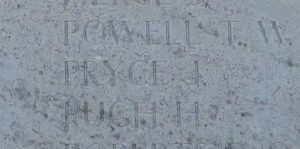
John Pugh, Private, 291285, Royal Welsh Fusiliers. John was the son of David and Harriet Pugh, of Belle View, Trefeglwys. He worked as a waggoner prior to enlisting into the 7th Battalion, Royal Welsh Fusiliers at Newtown on 27 November 1915, and was posted to the 3/7th Battalion, Royal Welsh Fusiliers at Park Hall, Oswestry for training. John embarked at Devonport on 31 May 1916, and disembarked in Alexandria on 11 June, before being posted to the 1/7th Battalion, Royal Welsh Fusiliers. The battalion was attached to 158 Brigade, 53rd (Welsh) Division, and had been evacuated from Gallipoli in December 1915, moving to Egypt to join the EEF, and helped guard the Suez Canal before taking part in operations to drive the Turks out of the Sinai. The EEF then turned its attention onto driving the Turks out of Palestine, and on 26 March 1917 launched its first offensive against the coastal city of Gaza, which guarded the road to Jerusalem. Initial gains during the day were lost when the assaulting divisions lost touch with each other and communication broke down when a thick fog cloaked the battlefield. John was killed in action during the terrible fighting that day. The 22-year-old is buried in Gaza War Cemetery, Israel.
Thomas Rees, Gunner, 215603, Royal Garrison Artillery. Thomas was the son of Meredith and Jane Rees, of Nantymelin, Staylittle, Llanbrynmair, Montgomeryshire. He resided at Pantyddauddwr, Cross Hands prior to the war, where he worked as a collier in the Gwendraeth Valley, and enlisted at Llanelli on 23 February 1916 into the Royal Garrison Artillery. Thomas was posted to France on 3 May 1918 and joined the 503rd Siege Battery, Royal Garrison Artillery, which was attached to the Third Army. During August 1918 the Third Army were on the Somme, where the Allies were planning to launch their great offensive, which ultimately led to the winning of the war. On 22 August 1918 Thomas had gone for a walk to an orchard at Bienvillers, and was filling his hat with apples to bring back to his gun crew when he was killed by a grenade explosion. Fellow crew members ran to his aid after hearing the explosion, only to find Thomas lying dead, with his cap in his hand. A subsequent court of enquiry ruled out suicide, and ruled his death as being accidental. Whether or not he was using grenades to attempt to blow apples from the tree is a mystery. Thomas was 23 years old when he was killed that day, and is buried in Bienvillers Military Cemetery, France.
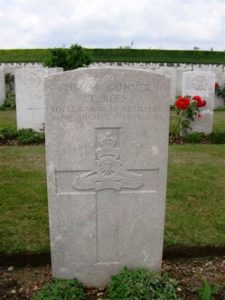
David Richards, Private, 291281, Royal Welsh Fusiliers. David was the son of Evan and Jane Richards, of Llawryglyn. He worked as a Waggoner prior to enlisting into the 7th Battalion, Royal Welsh Fusiliers at Newtown on 27 November 1915, and was posted to the 3/7th Battalion, Royal Welsh Fusiliers at Park Hall, Oswestry for training. David embarked at Devonport on 31 May 1916, and disembarked in Alexandria on 11 June, before being posted to the 1/7th Battalion, Royal Welsh Fusiliers. The battalion was attached to 158 Brigade, 53rd (Welsh) Division, and had been evacuated from Gallipoli in December 1915, moving to Egypt to join the EEF, and helped guard the Suez Canal before taking part in operations to drive the Turks out of the Sinai. The EEF then turned its attention onto driving the Turks out of Palestine, and on 26 March 1917 launched its first offensive against the coastal city of Gaza, which guarded the road to Jerusalem. Initial gains during the day were lost when the assaulting divisions lost touch with each other and communication broke down when a thick fog cloaked the battlefield. A second attempt to force Gaza was launched on 17 April, which also failed, and the EEF suffered a change in leadership, with Sir Edmund Allenby assuming command, before being re-organised, and a third offensive was launched against a wider front from Beersheba to Gaza on 31 October 1917. This time the Turkish defences were breached, and the road to Jerusalem now lay open and the EEF began to advance north. On 6 November 1917, 158 Brigade launched an attack on the Khuweilfeh Heights. David was killed in action during the attack that day. The 24-year-old is buried in Beersheba War Cemetery, Israel.
Daniel Tilsley, Private, 54203, Durham Light Infantry. Daniel was the son of William Tilsley and Catherine Tilsley (nee Ashton), of Dolgenau, Llawryglyn. He worked as a coal miner at Gilfach Goch prior to enlisting into the Royal Field Artillery at Tonypandy on 26 April 1915, and was posted to Pwllheli, joining D Battery, 121st Brigade, Royal Field Artillery, which was attached to the 38th (Welsh) Division. He married Kate Jones (nee Williams), a widow from Pwllheli on 30 December 1915. By now the 38th (Welsh) Division had embarked for France, but Daniel had remained in Britain with the 57th Reserve Battery, before transferring to the infantry, and was posted to the 9th Battalion, Durham Light Infantry on 27 November 1916. On 8 January 1917 Daniel embarked for France, and was posted to D Company of the 13th Battalion, Durham Light Infantry. The battalion was at Ypres, attached to 68 Brigade, 23rd Division when Daniel arrived. The Division remained at Ypres over the coming months, its infantry battalions carrying out the usual routines of trench rotation, usually four days in the front line, four in support, and four in reserve, interspersed with supplying working parties and carrying out trench raids. On 7 June 1917 the Battle of Messines Ridge opened just to the south, with the blowing of a series of vast underground mines. As a diversionary measure, another large mine was blown under Hill 60 at the same time, and the 23rd Division assaulted the hill. On 12 June the 13th DLI was relieved, and moved to Mont-des-Cats to rest. The main Passchendaele offensive opened on 31 July 1917, while the 23rd Division was still in reserve, now at Wizernes. By 30 August the Division had moved back into the battle zone, to the camp at Dickebusch, and on 19 September the 13th DLI took over the line in the Railway Wood sector. On the following morning, 20 September 1917, the battalion launched an assault towards Gheluvelt. Daniel was killed in action during the attack that day. The 32-year-old has no known grave and is commemorated on the Tyne Cot Memorial, Belgium.
Thomas Watkins, Private, G/3439, Queen’s Own (Royal West Kent Regiment). Thomas was born in 1879, the son of Richard Watkins and Hannah Watkins (nee Richards), of Brynwgan, Trefeglwys. He worked as a coal miner, and resided at Ton Pentre prior to the war. Thomas enlisted at Pentre into the 8th Battalion, Queen’s Own (Royal West Kent Regiment) soon after the outbreak of war. The battalion had formed at Maidstone in September 1914, moving to Shoreham to join 72 Brigade, 24th Division. Thomas landed in France with the battalion on 30 August 1915, and the entire Division moved to reserve positions near Loos. Within weeks of landing, the inexperienced Division was thrown into action at Loos on the second day of the battle, 26 September, and suffered terrible casualties. It was then withdrawn from the line, and didn’t see action until the summer of 1916 when it was moved to the Somme. Thomas was transferred to the 1st Battalion, Queen’s Own (Royal West Kent Regiment) at some time after this. The battalion was attached to 13 Brigade, 5th Division. The Division fought throughout the Somme offensive in the summer of 1916, and after suffering heavy casualties, the Division moved to Festubert, where it remained until March 1917. The Division next saw action at the Battle of Arras, fighting at the Battle of Vimy in April 1917, and the attack on La Coulette. On 3 May it fought in the Third Battle of the Scarpe, and captured Oppy Wood. On 7 September, the Division was transferred north to take part in the Passchendaele offensive, but in December it was one of the Divisions selected to be sent to Italy, to reinforce the Italian front. The Division was hurried back to France in March 1918, and moved to Flanders during the height of the German Spring offensive. In the middle of August 1918, the Division was pulled from the line to Arcade Camp near Hazebrouck to rest and rebuild, then moved south, back into the line near Gommecourt, to take part in the great Allied offensive, which was launched along the Western Front on 21 August. The Division was in support of the 37th Division during the initial attack, then moved through the Division to take up the offensive. Within days the Division had taken Grevillers and Achiet-le-Petit before reaching Favreuil, skiting north of Bapaume, and by 26 August had taken Beugnatre. The offensive continued towards the Canal du Nord and the Hindenburg Line over the coming weeks. On 18 September 1918 the Allies made a huge attack, known as the Battle of Épehy, just to the south of the 5th Division. During the day, the 1st Queen’s Own, remained in their trenches, enduring a particularly hostile spell of almost incessant artillery fire mixed with gas shell. Thomas was killed in action during the day, most probably as a result of this artillery-fire. The 39-year-old was originally buried on the battlefield, beside two other comrades, but after the war their graves were exhumed, and the men were re-interred in Gouzeaucourt New British Cemetery, France.
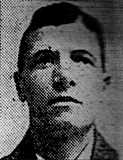
Hugh Cadifor Wood, Private, 50251, North Staffordshire Regiment. Hugh was the son of John and Jane Wood, of Hafren Street, Llanidloes. He worked as a builder at Loughor prior to the war and lodged at 12, Duffryn Place, Gorseinon. He married Maggie Owen, of Trefeglwys, Montgomeryshire in 1913 before moving there and the couple had two sons during the coming years. Hugh enlisted into the Royal Engineers on 15 December 1915 and was mobilised in February 1917. Upon landing in France, he was transferred to the 9th Battalion, North Staffordshire Regiment, which was a Pioneer unit attached to the 37th Division. Hugh was wounded during the time of the German offensives and evacuated to No 9 General Hospital, where he died of wounds on 21 May 1918 aged 28. He is buried in St. Sever Cemetery Extension, Rouen, France.
World War Two, 1939-1945
Ieuan Iorwerth Jones, Flight Lieutenant, 120982, Royal Air Force Volunteer Reserve. Ieuan was the son of Thomas Jones and Edith Jones (nee Hughes), of Nantisgylwch, Llawryglyn. He was a schoolteacher prior to the war, and lodged at Petton Hall, Burlton, Shropshire. Ieuan married a fellow teacher, Margery Ellen Bartlett at Hasfield, Gloucester on 26 December 1937. Ieuan enlisted into the Royal Air Force Volunteer Reserve after the outbreak of war, and trained as a Pilot before being posted to 218 Squadron, RAF. The Squadron had been in France with the BEF in 1940, before being evacuated to England, where it re-equipped with the Bristol Blenheim. In November, it rearmed with Vickers Wellingtons, and began bombing a wide variety of enemy targets with the new longer-range planes. In December 1941, the squadron began rearming with Short Stirlings and continued its bombing raids in occupied Europe, moving to RAF Downham Market in July 1942 and in March 1944 moved to RAF Woolfox Lodge in Rutland. In the weeks leading up to the D-Day invasions in Normandy, the Squadron carried out a number of diversionary bombing raids against defences in the Pas de Calais. On 2 May 1944, Ieuan took off from Woolfox Lodge, flying Stirling III, Serial EF504, which was part of a flight sent to bomb railway yards in stores depots near Amiens. The aircraft crashed in France that day, killing all her crew. Ieuan was 29-years-old when he lost his life during the crash, and was buried alongside his crew in Poix-De-Picardie Churchyard, France.